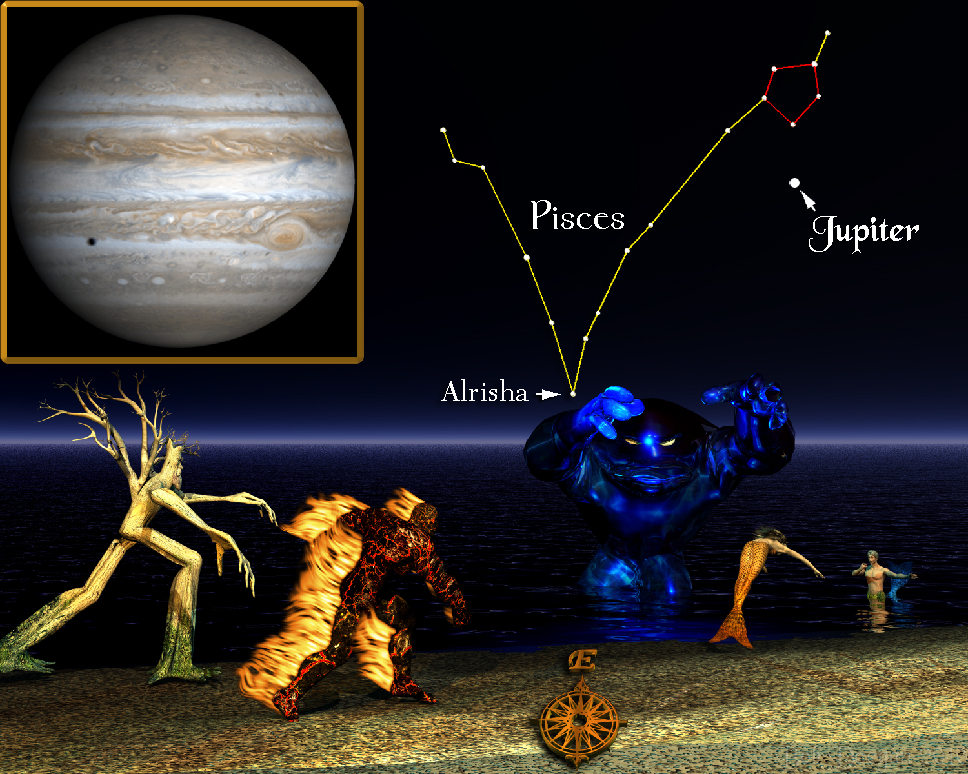
For the week including September 10, 2010

PISCES
Around midevening, you can see the constellation of Pisces, the Fish rising above the eastern horizon. Pisces is one of the faintest constellations of the zodiac, but this year the brilliant planet Jupiter is among its stars, making it easy to spot. Start by noting Jupiter, by far the brightest object in the eastern sky. It will be in a large dark area surrounded by brighter stars. Inside that region is the V-shape of Pisces, the Fish. You’ll know you’ve got it when you see the Circlet, a roundish group of stars highlighted in red in our illustration.
Pisces is one of the oldest constellations and many ancient cultures saw these stars as fish. The most popular story regarding the origin of the Fish comes from Greek mythology. In their legend, our world was originally ruled by deities named Uranus (Sky) and Gaia (Earth). Their offspring, the Titans, took many forms and mostly represented nature’s forces and elements. During this period, people didn’t age and lived in a virtual paradise. It didn’t last long though. Uranus was eventually overthrown by his son Kronos (Father Time -- he was known to the Romans as Saturn). Kronos himself was overthrown by his son, Zeus, who established the gods of Olympus. With each revolution among the gods, things got a bit worse for people and by the time Zeus took power, the world was about as we find it today. The Titans didn’t care much for the new management and decided to go to war with Olympus. Their leader was the youngest son of Gaia, a gigantic monster of a brute named Typhon. As Titans went, he wasn’t particularly good looking. He had a hundred heads and a hundred snakes sprouted from his body. When he was angry and spread his enormous bat wings, the Sun was blotted from the sky. He also had a nasty habit of belching fire now and again.
On the day of their epic battle, Typhon and his minions charged Zeus and the gods of Mount Olympus. Elsewhere, Aphrodite and her son Eros were walking near a river when the sky went suddenly dark and they were set upon by a group of Titans. Thinking quickly, they changed into fish and, binding themselves with a cord to avoid separation, they swam to safety. When Zeus dropped a mountain on Typhon, the Titans scattered and the fight was over. During their victory celebration, the gods commemorated the escape of Eros and Aphrodite by placing their fish among the stars. Typhon remains buried under Mount Etna in Sicily, but his fiery breath still spouts from the mouth of the volcano.
The reason why Jupiter looks larger than the stars around it has to do with its size. The gas-giant Jupiter (shown at upper left) is 88,730 miles in diameter, so immense that all of the other planets in the solar system could fit inside it. If we were to take our solar system as a whole, the Sun would represent about 98% of its mass. Jupiter, by itself, would represent half of what’s leftover.
If you look at Jupiter with binoculars, you will immediately see four of its moons, Io, Callisto, Europa, and Ganymede. Galileo discovered these moons in 1610, just a few months after he started experimenting with a new Dutch invention he called a telescope. Because these moons orbit Jupiter at a very high speed (Io completes an orbit in a little over a day and you can see its shadow at the left side of Jupiter in the NASA photograph above.), each night that you observe the moons you will find them in different positions. At times, just an hour’s wait will be enough to show a clear change. Of these moons, Ganymede is the largest. Actually it’s the biggest moon in the solar system, larger than the planet Mercury. On a clear, dark night, when Ganymede’s orbit takes it farthest away from the bright planet, it can be seen with the naked eye as a tiny dot of light.Observing Jupiter with a telescope reveals many light and dark bands in its atmosphere. The banding is caused by the planet’s rapid rotation. Jupiter spins through its day in an amazing ten hours. That’s pretty fast considering that Jupiter is large enough to fit over 1,300 planet Earth’s inside. This gyration has created hurricane-like weather structures all over Jupiter. Chief among these is an oval-shaped vortex near the planet’s equator (visible at lower right). Called the Great Red Spot, this storm has winds that blow at over 700 miles an hour and it’s been raging non-stop for over 400 years.
While you have your telescope out, take a look at Alrisha, the star representing the knot in the cord. It’s actually a beautiful binary star system.
Unless otherwise indicated, all content of this web site is the copyright of Robert Deegan and all rights are reserved.
For more information, or to comment, please contact: Bob@NightSkies.org